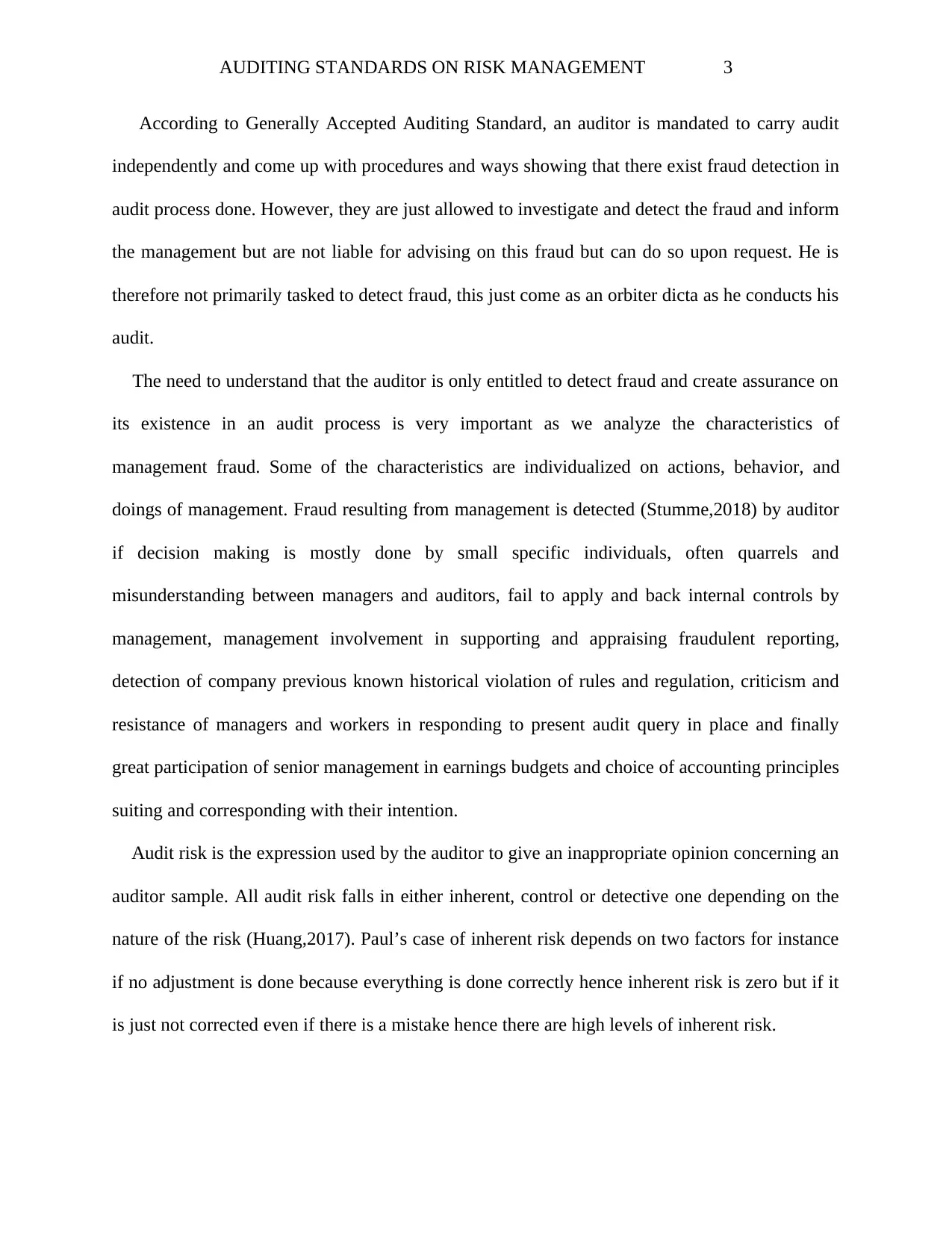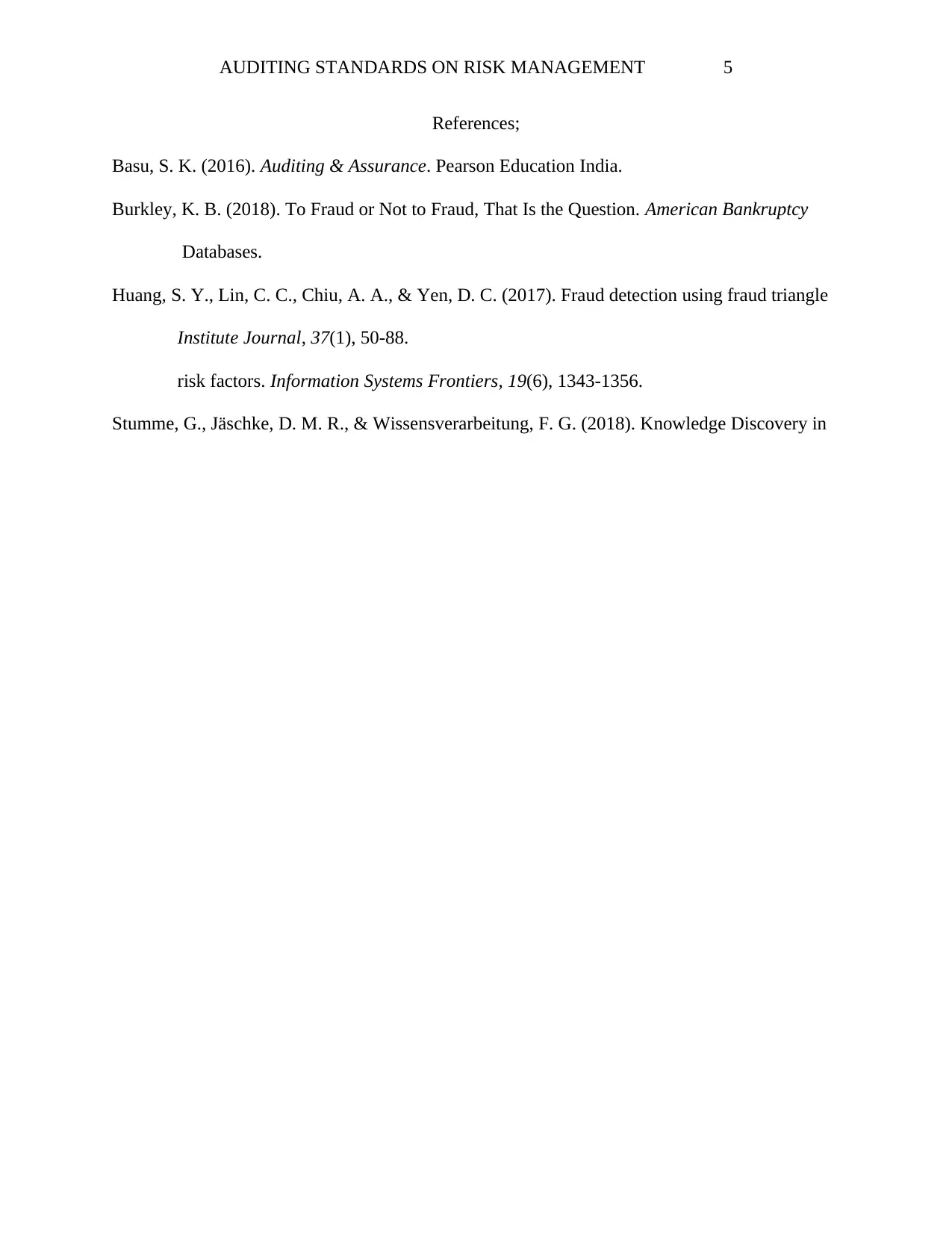Risk Analysis, Detection & Management in South Africa Report
VerifiedAdded on 2021/06/17
|5
|886
|82
Report
AI Summary
This report provides an analysis of risk, detection, and management within the South African context, focusing on audit standards and the distinctions between management fraud and defalcation. The report references International Standards on Audit (ISA), South African Audit Practice Statements (SAAPS), and Generally Accepted Auditing Standards. It differentiates between management fraud, which involves intentionally misleading financial statements, and defalcation, which involves misappropriation of company resources. The report also examines the characteristics of management fraud and the auditor's role in detecting it, including the assessment of audit risk and the factors influencing inherent risk. The conclusion emphasizes compliance with relevant audit standards and practices, providing a comprehensive overview of risk management principles in the South African market.

Running head: AUDITING STANDARDS ON RISK MANAGEMENT 1
Risk Analysis, Detection & Management in South Africa
Student’s Name
Institutional Affiliation
Risk Analysis, Detection & Management in South Africa
Student’s Name
Institutional Affiliation
Paraphrase This Document
Need a fresh take? Get an instant paraphrase of this document with our AI Paraphraser

AUDITING STANDARDS ON RISK MANAGEMENT 2
Introduction;
Review on audit standards in the South African market is seen to explain and regulate
how audit process is to be conducted so as to provide the face of truth and fairness pursuant to
requirement and compliance state set in the International Standards on Audit. Audit in South
Africa is likewise guided by South African Audit Practice Statements (SAAPS) that outlines and
guides on audit start, review, assurance and skeptic-related issues that should be in conformity
with International Standard on Audit requirement in lieu.
It is from this standards i.e. both SAAP and of course the pillar of audit ISA that a distinction
between management fraud and defalcation is drawn. SAS No 82 states that the main distinction
between management fraud and defalcation (Burkley,2018) is the urge or intention of conducting
the activity as well as the co-purpose on the result. Management fraud entails a deliberate or
rather intended use of fraudulent or misleading financial statement to wrongly blackmail and
inform the users of these statements both internal and external i.e. suppliers, investors,
shareholders, owners, customers and the general public. On the hand defalcation is
misappropriation and misallocation of company resources mainly assets and funds.
It is therefore certain that the two aspect are differentiated by the intention or notion wherein
management fraud the main aim of the management is to misinform, mislead and misguide the
concerned by feeding with info that changes their mind on the negative thoughts they had on the
company thus creating an extension room for continuing doing wrong in the expense of
misinforming innocent minority parties. This fraud happens when management integrity is
diluted by ill motive minds and opportunistic in management. Defalcation is however committed
and indulged into out of greed, selfishness and ill motive personal interest.
Introduction;
Review on audit standards in the South African market is seen to explain and regulate
how audit process is to be conducted so as to provide the face of truth and fairness pursuant to
requirement and compliance state set in the International Standards on Audit. Audit in South
Africa is likewise guided by South African Audit Practice Statements (SAAPS) that outlines and
guides on audit start, review, assurance and skeptic-related issues that should be in conformity
with International Standard on Audit requirement in lieu.
It is from this standards i.e. both SAAP and of course the pillar of audit ISA that a distinction
between management fraud and defalcation is drawn. SAS No 82 states that the main distinction
between management fraud and defalcation (Burkley,2018) is the urge or intention of conducting
the activity as well as the co-purpose on the result. Management fraud entails a deliberate or
rather intended use of fraudulent or misleading financial statement to wrongly blackmail and
inform the users of these statements both internal and external i.e. suppliers, investors,
shareholders, owners, customers and the general public. On the hand defalcation is
misappropriation and misallocation of company resources mainly assets and funds.
It is therefore certain that the two aspect are differentiated by the intention or notion wherein
management fraud the main aim of the management is to misinform, mislead and misguide the
concerned by feeding with info that changes their mind on the negative thoughts they had on the
company thus creating an extension room for continuing doing wrong in the expense of
misinforming innocent minority parties. This fraud happens when management integrity is
diluted by ill motive minds and opportunistic in management. Defalcation is however committed
and indulged into out of greed, selfishness and ill motive personal interest.

AUDITING STANDARDS ON RISK MANAGEMENT 3
According to Generally Accepted Auditing Standard, an auditor is mandated to carry audit
independently and come up with procedures and ways showing that there exist fraud detection in
audit process done. However, they are just allowed to investigate and detect the fraud and inform
the management but are not liable for advising on this fraud but can do so upon request. He is
therefore not primarily tasked to detect fraud, this just come as an orbiter dicta as he conducts his
audit.
The need to understand that the auditor is only entitled to detect fraud and create assurance on
its existence in an audit process is very important as we analyze the characteristics of
management fraud. Some of the characteristics are individualized on actions, behavior, and
doings of management. Fraud resulting from management is detected (Stumme,2018) by auditor
if decision making is mostly done by small specific individuals, often quarrels and
misunderstanding between managers and auditors, fail to apply and back internal controls by
management, management involvement in supporting and appraising fraudulent reporting,
detection of company previous known historical violation of rules and regulation, criticism and
resistance of managers and workers in responding to present audit query in place and finally
great participation of senior management in earnings budgets and choice of accounting principles
suiting and corresponding with their intention.
Audit risk is the expression used by the auditor to give an inappropriate opinion concerning an
auditor sample. All audit risk falls in either inherent, control or detective one depending on the
nature of the risk (Huang,2017). Paul’s case of inherent risk depends on two factors for instance
if no adjustment is done because everything is done correctly hence inherent risk is zero but if it
is just not corrected even if there is a mistake hence there are high levels of inherent risk.
According to Generally Accepted Auditing Standard, an auditor is mandated to carry audit
independently and come up with procedures and ways showing that there exist fraud detection in
audit process done. However, they are just allowed to investigate and detect the fraud and inform
the management but are not liable for advising on this fraud but can do so upon request. He is
therefore not primarily tasked to detect fraud, this just come as an orbiter dicta as he conducts his
audit.
The need to understand that the auditor is only entitled to detect fraud and create assurance on
its existence in an audit process is very important as we analyze the characteristics of
management fraud. Some of the characteristics are individualized on actions, behavior, and
doings of management. Fraud resulting from management is detected (Stumme,2018) by auditor
if decision making is mostly done by small specific individuals, often quarrels and
misunderstanding between managers and auditors, fail to apply and back internal controls by
management, management involvement in supporting and appraising fraudulent reporting,
detection of company previous known historical violation of rules and regulation, criticism and
resistance of managers and workers in responding to present audit query in place and finally
great participation of senior management in earnings budgets and choice of accounting principles
suiting and corresponding with their intention.
Audit risk is the expression used by the auditor to give an inappropriate opinion concerning an
auditor sample. All audit risk falls in either inherent, control or detective one depending on the
nature of the risk (Huang,2017). Paul’s case of inherent risk depends on two factors for instance
if no adjustment is done because everything is done correctly hence inherent risk is zero but if it
is just not corrected even if there is a mistake hence there are high levels of inherent risk.
⊘ This is a preview!⊘
Do you want full access?
Subscribe today to unlock all pages.

Trusted by 1+ million students worldwide

AUDITING STANDARDS ON RISK MANAGEMENT 4
In case number 2 there is a presence of almost next to zero inherent risks mainly because
Field, PA though he is lazily decided to conduct substantive procedure which to our case it
seems to be the expected one after cross-examining, testing and qualifying the possible
transactions available. This thus qualifies Field to no need to have inherent risk especially after
conduction of substantive test taken.
Conclusion;
The above information shared complies with International Standards on Audit as well as
Generally Accepted Audit Standards and South African Audit Practice Statements in place
(Basu, 2016.)
+
In case number 2 there is a presence of almost next to zero inherent risks mainly because
Field, PA though he is lazily decided to conduct substantive procedure which to our case it
seems to be the expected one after cross-examining, testing and qualifying the possible
transactions available. This thus qualifies Field to no need to have inherent risk especially after
conduction of substantive test taken.
Conclusion;
The above information shared complies with International Standards on Audit as well as
Generally Accepted Audit Standards and South African Audit Practice Statements in place
(Basu, 2016.)
+
Paraphrase This Document
Need a fresh take? Get an instant paraphrase of this document with our AI Paraphraser

AUDITING STANDARDS ON RISK MANAGEMENT 5
References;
Basu, S. K. (2016). Auditing & Assurance. Pearson Education India.
Burkley, K. B. (2018). To Fraud or Not to Fraud, That Is the Question. American Bankruptcy
Databases.
Huang, S. Y., Lin, C. C., Chiu, A. A., & Yen, D. C. (2017). Fraud detection using fraud triangle
Institute Journal, 37(1), 50-88.
risk factors. Information Systems Frontiers, 19(6), 1343-1356.
Stumme, G., Jäschke, D. M. R., & Wissensverarbeitung, F. G. (2018). Knowledge Discovery in
References;
Basu, S. K. (2016). Auditing & Assurance. Pearson Education India.
Burkley, K. B. (2018). To Fraud or Not to Fraud, That Is the Question. American Bankruptcy
Databases.
Huang, S. Y., Lin, C. C., Chiu, A. A., & Yen, D. C. (2017). Fraud detection using fraud triangle
Institute Journal, 37(1), 50-88.
risk factors. Information Systems Frontiers, 19(6), 1343-1356.
Stumme, G., Jäschke, D. M. R., & Wissensverarbeitung, F. G. (2018). Knowledge Discovery in
1 out of 5
Related Documents
Your All-in-One AI-Powered Toolkit for Academic Success.
+13062052269
info@desklib.com
Available 24*7 on WhatsApp / Email
![[object Object]](/_next/static/media/star-bottom.7253800d.svg)
Unlock your academic potential
Copyright © 2020–2025 A2Z Services. All Rights Reserved. Developed and managed by ZUCOL.




